An automatic parking system is a technology designed to assist drivers in parking their vehicles with minimal manual input. These systems typically utilize various sensors, cameras, and computer algorithms to detect available parking spaces, guide the vehicle into the spot, and sometimes even handle the steering, acceleration, and braking.

Automated parking systems have revolutionized the way we approach parking spaces, increasing efficiency, saving space, and minimizing environmental impact in a fast-paced world of technological advancement.
If you want to know about the Types of slabs or Permeable concrete or Islamic architecture, please click the link.
1) History
It’s fascinating how the concept of mechanical parking systems has evolved over time, isn’t it? From the early semi-automatic setups like the one in Paris in 1905 to the more advanced systems we see today, there’s been a constant drive to optimize space and efficiency in urban environments. The history you’ve provided offers a glimpse into the ingenuity and innovation that has shaped the development of parking solutions over the years.

The adoption of mechanical parking systems, particularly in places like the USA and Japan, underscores the importance of addressing the challenges posed by limited space and increasing urbanization. It’s interesting to note the role of government policies, such as tax incentives, in stimulating the growth of these systems in certain regions.

And with advancements in technology, it’s no surprise that these systems have become faster, more reliable, and user-friendly over time. It’s a testament to human creativity and engineering prowess how these solutions continue to evolve to meet the needs of modern urban living
2) Difference between fully & semi-automatic parking
The main difference between fully and semi-automatic parking systems lies in the level of automation and user involvement:
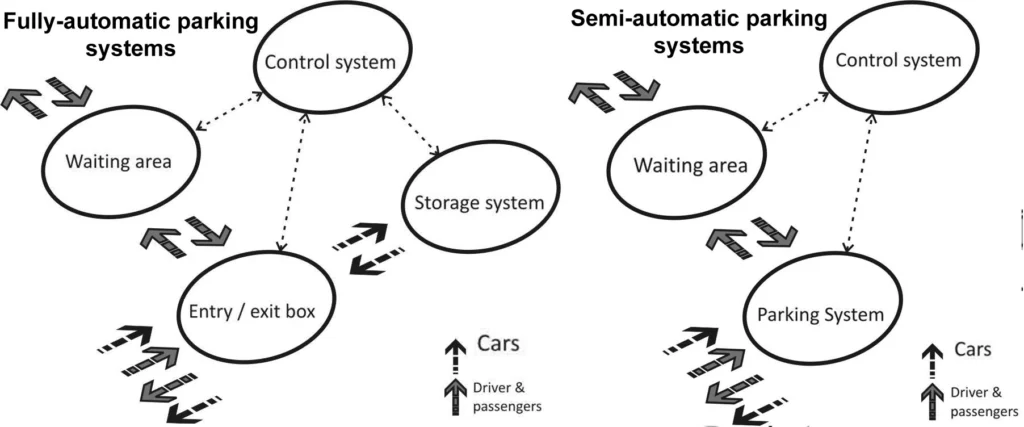
i) Fully-automatic Parking Systems:

Fully-automatic parking systems operate without human intervention. Once a car is handed over to the system at the transfer cabin, the system takes complete control of the vehicle’s movement.
The main gate closes, and a conveyor system transports the car to a parking place. Users can request their car to be returned to the exit, with all operations being fully automated.
ii) Semi-automatic Parking Systems:
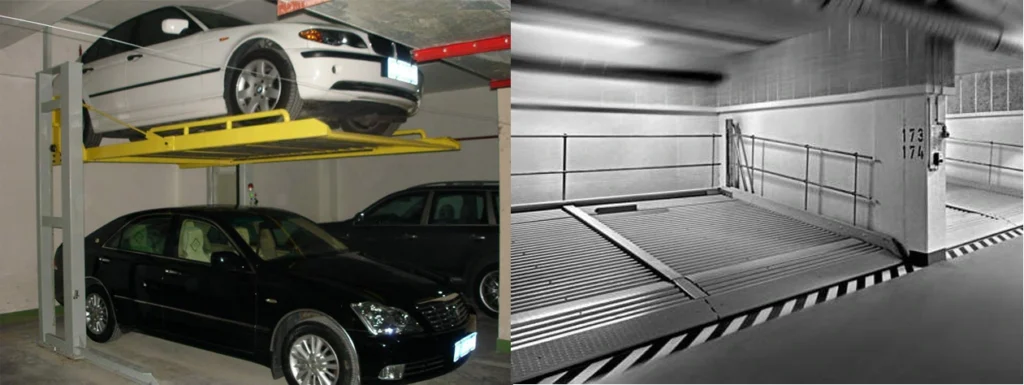
Semi-automatic parking facilities allow users to drive their cars into the garage and park them on platforms. Users can then operate the system to create additional parking spaces by lifting and/or sliding platforms.
This enables doubling or tripling of parking capacity while maintaining a layout similar to conventional parking setups.
3) Fully-automatic Systems
i) Functionality
The basic functionality of a fully-automatic parking garage revolves around seamless operations without human intervention. Here’s a breakdown of its key functions:
- Entry and Exit of Cars: The system allows cars to enter and exit the transfer cabin safely and efficiently.
- Transfer of Cars: Once a car is in the transfer cabin, the main gate closes, and a conveyor system moves the car to its designated parking place. Likewise, when requested by the user, the car is retrieved from its parking place and moved back to the transfer cabin.
- User Interaction: Throughout the entire process, the system interacts with the user to ensure smooth operation. This interaction may involve providing instructions, status updates, or responding to user requests.
In addition to these primary functions, the system also includes the following sub-functions:
- Service Facilitation: The system facilitates maintenance and servicing tasks, ensuring that the parking garage operates optimally at all times. This may include periodic inspections, repairs, or adjustments to mechanical components.
- Management Support: The system provides tools and features to support efficient management of the parking garage. This could involve tracking occupancy, managing reservations, generating reports, and optimizing parking allocation.
- Safety and Security: Ensuring the safety of both people and vehicles is paramount. The system incorporates measures such as sensors, safety protocols, and emergency procedures to prevent accidents and mitigate risks. It also includes features for securing the cars against theft or damage.
By efficiently managing these functions and sub-functions, a fully-automatic parking garage provides a convenient and secure parking solution for users while optimizing space and resources.
ii) Benefits
Fully-automatic parking systems offer several advantages over traditional garages, parking lots, semi-automatic systems, and car elevators:
Advantages
- Increased Parking Capacity: More cars can be parked in the same volume compared to traditional parking setups, optimizing space usage.
- Space Efficiency: Less space is required to accommodate the same number of parking places, allowing for more flexibility in designing parking structures.
- Cost Savings: Lower total construction costs per parking place in densely populated urban areas due to efficient space utilization.
- Enhanced Vehicle Protection: Cars are better protected against damage, theft, and burglary since they are securely stored within the automated system.
- Improved User Experience: Users avoid navigating through difficult or unpleasant parking environments and don’t need to walk through parking areas, enhancing convenience and safety.
- Lower Infrastructure Standards: Parking areas can have lower standards for lighting, ventilation, accessibility, and overall finish, reducing construction and maintenance costs.
- Environmental Benefits: Reduced emissions of CO2, exhaust fumes, and particulate matter since car engines are not running inside the parking facility, contributing to a cleaner environment.
However, there are some disadvantages to fully-automatic parking systems:
Disadvantages
- System Failure Impact: In case of a general system failure, no cars can enter or leave the parking facility until the issue is resolved, potentially causing inconvenience for users.
- Maintenance Requirements: These systems require a reasonable amount of periodic servicing to ensure smooth operation and reliability.
- Integration Challenges: Integrating fully-automatic parking systems into overall projects can be challenging both technically and from a managerial standpoint, requiring careful planning and coordination.
Despite these challenges, the benefits of fully-automatic parking systems often outweigh the drawbacks, especially in densely populated urban areas where space optimization and convenience are crucial.
iii) Components
The main components of a fully-automatic parking system include:

Transfer Cabin:
This is where users hand over their cars to the system. It interacts with the user and checks the main dimensions of the car for safe transfer. Safety features are crucial here.

Components include a turning device, main gate, receiver for remote control or RFID system, traffic light, side door, car dimension scanners, working area door, motion detectors, information display, and mirrors.
Waiting Area:
Located next to the transfer cabin, this area allows users to give instructions to the system and stay informed about its operations. Components include a control panel with a display and a card reader for user identification.
Storage System:
This is the electro-mechanical system responsible for moving cars between the transfer cabin and their parking places. It can be divided into shuttle systems and puzzle systems. Shuttle systems use corridors and transportation devices (shuttles) to move cars, while puzzle systems operate without corridors.
Shuttle systems can further be categorized based on whether they use pallets for parking cars or not. Additionally, shuttle systems can have multiple rows of parking places behind each other, increasing compactness but requiring some parking places to be left open for maneuvering.
Here’s an overview of possible fully-automatic storage systems:
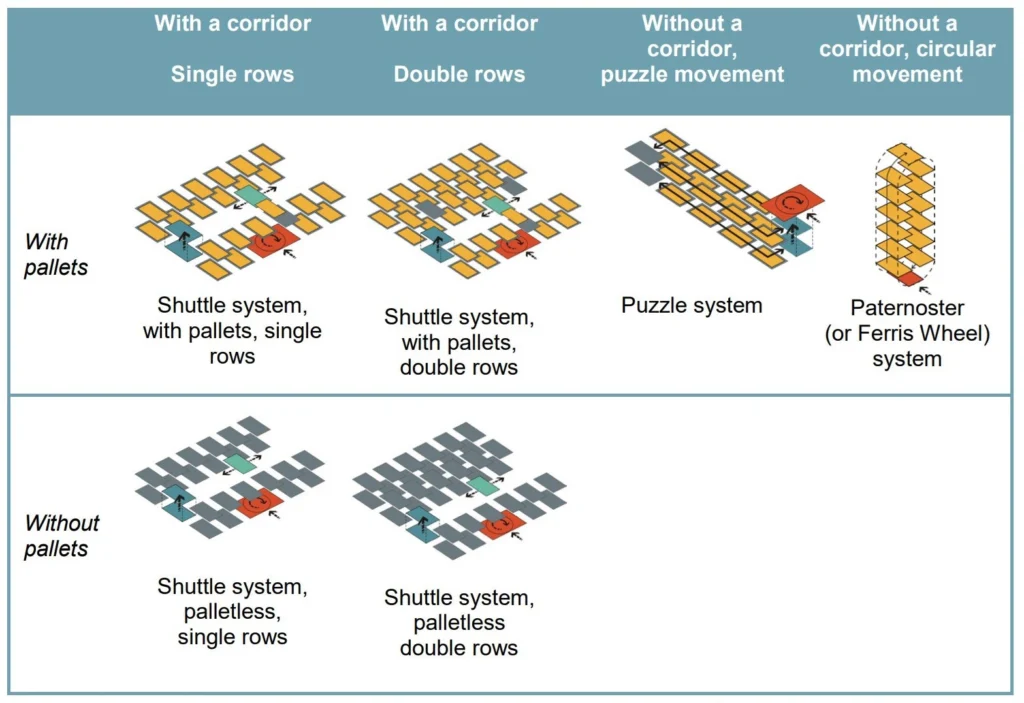
In parking systems with pallets, the user parks the car on a pallet in the transfer cabin, and the system moves the pallet (and the car) through the garage. In systems without pallets, the car can be moved either by mechanically grabbing the wheels or using conveyor belts.

In palletless shuttle systems, conveyor belts are installed on the shuttle, parking places, and transfer cabin. The conveyor belt moves the car once the user has left the transfer cabin.
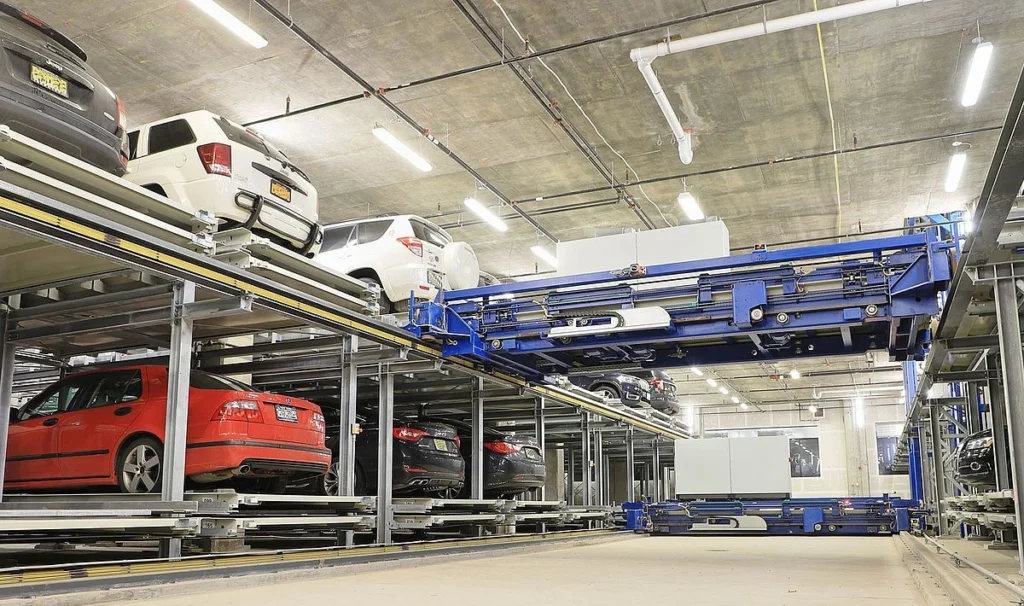
Systems without a corridor move cars on pallets through the garage.
In puzzle systems, pallets move independently, creating a sliding motion similar to promotional puzzles.
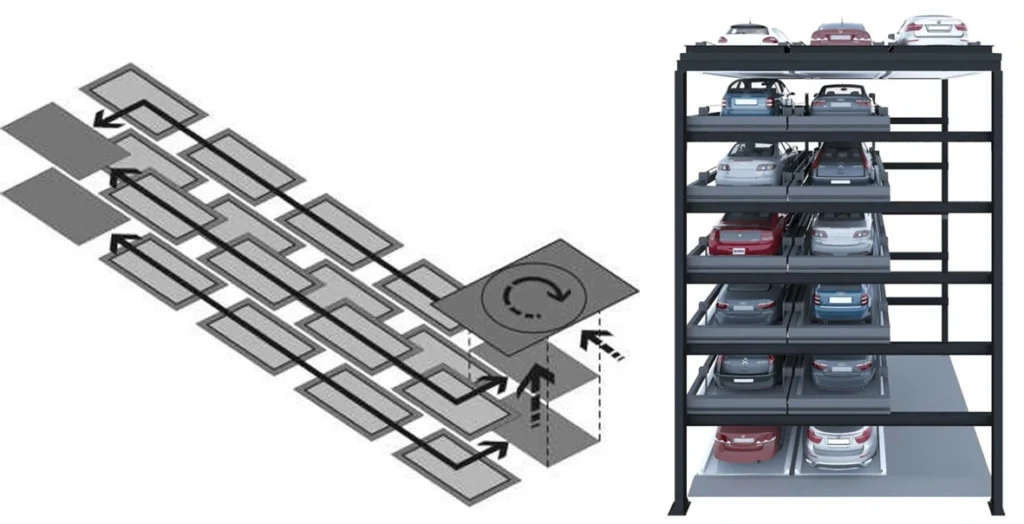
In Paternoster systems, pallets are connected, and the entire system rotates to bring the desired car to the transfer cabin.
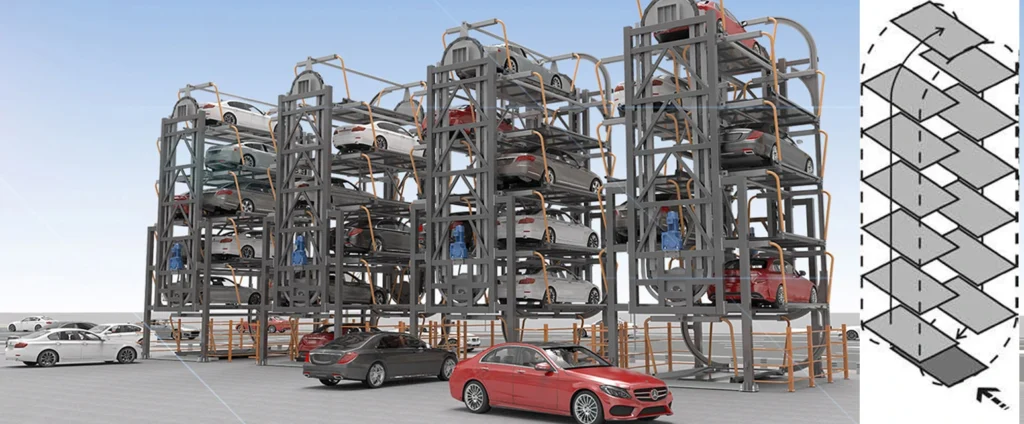
The main components of the storage system include:
- Horizontal conveyor system
- Elevator (sometimes integrated with a horizontal conveyor system)
- Turning device (often integrated in the transfer cabin)
- Centering device (often integrated in the transfer cabin)
These components ensure smooth movement and positioning of cars within the parking system. Some systems also include features for turning the car and centering it in tight spots.
Control system:
The control system serves as the centralized, computerized hub of the parking garage, overseeing and managing all its operations. Typically located in a control room accessible only to authorized personnel, it allows for intervention in system functioning, such as troubleshooting malfunctions, correcting user errors, or conducting routine maintenance.
Additionally, the control system generates management reports containing valuable information like occupancy rates, usage patterns, and availability of parking spaces.
For larger public garages and office buildings, user service control terminals may be deployed. These terminals enable trained service personnel to operate the system, issuing basic instructions for parking and retrieving cars.
The main components of the control system include:
- Control cabinet with PLC (Programmable Logic Controller): This serves as the brain of the system, executing commands and coordinating various functions.
- Service terminal: Equipped with a graphical user interface, this terminal allows authorized personnel to interact with the control system, accessing functionalities for system management and monitoring.
- Remote service terminal: Provides remote access to the control system, enabling off-site monitoring and maintenance.
- Mobile service panel: Allows service personnel to access and control the system from different locations within the facility, providing flexibility and convenience in managing system operations.
These components work together to ensure the efficient and reliable operation of the fully-automatic parking garage, while also facilitating maintenance, troubleshooting, and reporting functionalities.
4) Semi-automatic Systems
i) Functionality
In semi-automatic parking facilities, users drive their cars into the garage and park them on a platform. Once parked, users can exit their cars and operate the system to create access to additional parking places by lifting and/or shifting one or more parking platforms. This allows for the doubling or tripling of parking capacity while maintaining a layout similar to conventional parking setups.
The main functionality of semi-automatic parking facilities can be broken down into the following sub-functions:
- Entry and Exit: Allowing cars to enter and leave the storage system safely and efficiently.
- Platform Manipulation: Adjusting the position of parking platforms to create access to other parking places, thereby maximizing parking capacity.
- User Communication: Providing clear communication with users throughout the entire parking process, ensuring smooth operation and user understanding.
In addition to these main functionalities, the system also serves the following sub-functions related to safety and management:
- Service Facilitation: Supporting maintenance and servicing tasks to ensure the proper functioning of the system over time.
- Management Support: Providing tools and features to assist in the efficient management of the parking facility, including tracking occupancy, managing reservations, and optimizing parking allocation.
- Safety and Security: Ensuring the safety of both people and vehicles within the facility, implementing measures to prevent accidents and protect against theft or damage.
By efficiently managing these functions and sub-functions, semi-automatic parking facilities offer a practical solution for maximizing parking capacity in urban environments while prioritizing safety and user experience.
ii) Benefits
Semi-automatic parking systems offer several advantages over traditional garages and parking lots:
- Increased Parking Capacity: More cars can be parked in a given volume, maximizing space efficiency.
- Space Optimization: Less space is required for a given number of parking places, allowing for more flexibility in the shape of the parking facility.
- Cost Efficiency: Lower total construction costs per parking place, especially in highly urbanized areas where land is at a premium.
When compared to fully-automatic parking systems, semi-automatic systems have additional benefits:
- Lower Construction Costs: Semi-automatic systems typically require lower initial investment costs per parking place.
- Familiar Layout: The general layout of the facility remains similar to conventional parking setups, making it easier for users to adapt.
However, semi-automatic systems do have some disadvantages compared to traditional garages and fully-automatic parking systems:
- User Training Required: Users need some training to operate the system safely, and the responsibility for safety rests with the user. Therefore, these systems may not be suitable for public use by inexperienced or untrained users.
When compared to fully-automatic parking systems and car elevators, semi-automatic systems have several drawbacks:
- Accessibility Requirements: The working area needs to be accessible for users, resulting in less compact layouts and requiring better lighting, ventilation, and overall finish.
- User Responsibility for Safety: Similar to the previous point, users are responsible for operating the system safely, which may limit its suitability for public use by untrained individuals.
- Limited Vehicle Protection: Cars are not as well protected against damage, theft, and burglary compared to fully-automatic systems, where cars are securely stored within the system.
Overall, while semi-automatic parking systems offer advantages in terms of increased capacity, cost efficiency, and familiar layouts, they also come with limitations related to user training, safety, and vehicle protection.
iii) Components
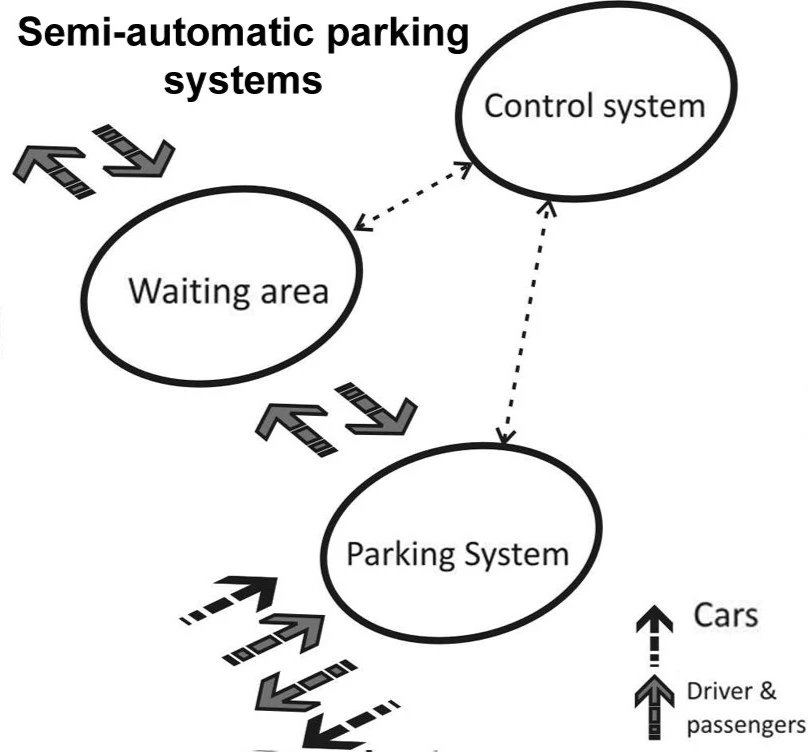
The main components of a semi-automatic parking system are:
- Waiting Area: This is where users instruct the system to make a parking place available if one is not already free. Users typically interact with the system through a control panel or similar interface located in the waiting area.
- Storage System: The storage system consists of an electromechanical system with lifting and/or shifting platforms on which users can park their cars. These platforms are manipulated to create additional parking spaces as needed.
- Control System: The control system handles all instructions given by users and controls the conveyor system responsible for moving the lifting and shifting platforms. It is typically housed in a wall-mounted industrial cabinet near the parking system, providing centralized control and management of the parking facility.
Each of these components plays a crucial role in the operation of the semi-automatic parking system, enabling efficient parking space management and user interaction.
Waiting Area
The waiting area serves as a point of interaction between users and the parking system, allowing users to provide instructions and receive feedback on system operations. Here’s a breakdown of its key components:
- Control Panel: Equipped with a display or indication lights, the control panel enables users to input instructions and receive information about the system’s status and operations. It provides a user-friendly interface for interacting with the parking system.
- Key Switch or Similar Device: A key switch or similar device is often used for user identification and authorization. This helps prevent unauthorized use of the system and ensures that only authorized users can operate it.
In situations where the waiting area is located next to the parking place, users can visually inspect the area to ensure it is safe for the system to start moving. If the waiting area is centralized, fences around the storage system may be used to guard other users from harm during operation.
In such cases, it’s essential to have a button or similar device near the parking place that provides a good overview of the situation and allows users to shut the gate after use and ensure no one is trapped within the gates.
Storage System
The storage system of a semi-automatic parking facility is designed to create additional parking spaces by lifting, shifting, or a combination of both, one or more parking platforms.

Here’s an overview of the types of systems available:
- Pit Systems: These systems require a pit for platforms with a car to be lowered into. They can have varying numbers of parking layers, typically ranging from one to three layers.
- Non-Pit Systems: These systems do not require a pit for platforms with cars. They also come in different configurations, ranging from single-layer shifting platforms to multiple-layer lifting and shifting platforms.
Based on the number of layers and whether they have pits, semi-automatic parking systems can be categorized as follows:
- Single Row Systems: These systems have platforms arranged in a single row.
- Multiple Row Systems: These systems have multiple rows of platforms, with paths created by lifting and/or shifting platforms in blocking rows to access parking places behind them.
Additionally, there are distinctions between systems based on whether they are dependent or independent:
- Dependent Systems: Cars may need to be manually removed to allow other cars to exit the system. This is common in systems like car stackers, where the lower car must leave for the upper car to exit.
- Independent Systems: These systems typically allow cars to leave without requiring other cars to be manually removed. However, whether a system is dependent or independent often depends on its layout, except for lifting systems without pits, which are typically always dependent.
By understanding these distinctions, users can choose the most suitable semi-automatic parking system based on their space constraints and operational requirements.
Control System
The control system of a semi-automatic parking system is generally simpler compared to that of a fully-automatic parking system. Here are some key characteristics:
- Simplicity: Semi-automatic parking systems may not include a Programmable Logic Controller (PLC). Instead, they are often controlled by a user-operated key switch, making the control system straightforward and easy to operate.
- Location: If a PLC is utilized, it is typically housed in a wall-mounted industrial cabinet near the parking system, providing centralized control.
- Limited Control Options: Unlike fully-automatic parking systems, semi-automatic systems usually do not include additional control options such as mobile service control panels, remote service control panels, or user service control terminals.
Overall, the control system of a semi-automatic parking system is designed for simplicity and ease of use, with a focus on basic functionality and user-operated controls.